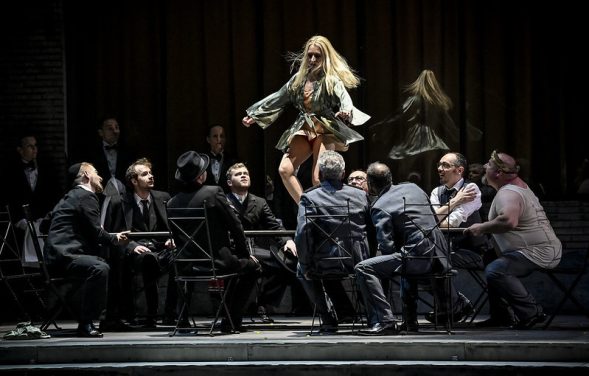 Czech Republic Richard Strauss, Salome: Soloists, Orchestra of Brno Opera / Marko Ivanovic (conductor). National Theatre Brno, 25.11.2023. (GT)
Czech Republic Richard Strauss, Salome: Soloists, Orchestra of Brno Opera / Marko Ivanovic (conductor). National Theatre Brno, 25.11.2023. (GT)

Production:
Director – David Radok
Scenery – Dragan Stojčevski
Costumes – Zuzana Ježková
Lighting – Přemysl Janda
Choreography – Andrea Miltnerová
Assistant director – Otakar Blaha
Cast:
Herod – Jaroslav Březina
Herodias – Eva Urbanová
Salome – Linda Ballová
Jochanaan – Birder Radda
Narraboth – Vit Nosek
The Page – Jana Hrochová
First Jew – Zbigniew Malak
Second Jew – Pavel Valenta
Third Jew – Petr Levíček
Fourth Jew – Michael Robotka
Fifth Jew – Kornel Mikecz
First Nazarene / First Soldier – Josef Škarka
Second Nazarene – Zoltan Korda
Second Soldier / A Cappadocian – David Nykl
A Slave – Jitka Zerhauová
Richard Strauss was not the first to write an opera on this biblical subject as Jules Massenet was inspired by Flaubert’s novella to compose Herodias. Another French composer, Antoine Mariotte wrote his own Salome, yet it was not performed until after Strauss’s opera received its premiere. After seeing Oscar Wilde’s play in Berlin in 1902, Strauss wrote: ‘Now, after all the dance and especially the final scenes are drowned in music, it is by no means bold to explain that this work “screamed with music.”’
This new Salome is only the fourth production in Brno, and its creator is one of the best Czech directors, David Radok. After a great production of Britten’s Peter Grimes in the 2021/22 season, Radok and his team – the chief conductor Marko Ivanović, costume designer Zuzana Ježková and Dragan Stojčevski as set designer, are reunited for the fifth time for the Brno Opera Company. In the pre-premiere publicity, the Brno Opera predicted that just like the original world premiere, the new Salome would be a sensation!
This new production premiered on 17 June this year, and the Brno company could hardly have expected the production would ominously hint at the present conflict in the Holy Land. This was underscored by the costumes and setting being set in the twentieth century. The costumes are mostly black, including the burqa of the Slave, played by Jitka Zerhauová. Salome is dressed in a silky green gown, while Herod is either in a uniform or a toga and Herodias is in a long sky-blue dress.
In the opening scene, we see a darkly lit courtyard with shadowy figures leaning or standing around. Inside Herod’s palace, a large window allows the audience to view events within; at times, Herod and Herodias are in conference or having a festive meal, there is a party, and later an orgy is underway. At times, in her moments of despair, Herodias gazes out from between the closed curtains. The front courtyard is sparse, and a rope hangs suspended above the underground cell where Jochanaan is imprisoned, and the characters wandering around in front of the palace seem to be waiting for something to happen allowing suspense to reign accompanied by Strauss’s captivatingly seductive orchestration.
Of course, a successful performance of this opera rests on the singing and characterisation of the title role of Salome and this production is much indebted to the extraordinary talents of Slovakian soprano Linda Ballová. She started with a honeyed-toned lyric soprano and her performance built steadily through to the terrible final scene, with her screaming for the lips of Jochanaan. The singing of Vit Nosek as Narraboth was superb as his vibrant tenor rang out in despair at his love for Salome, and his death was somewhat understated so we should get used to the violence of Herod’s kingdom. The Herod of Jaroslav Březina was excellent in characterising his greed and yearning for Salome, as if as her stepfather, he has the supreme right to her womanhood; his personality also conflicted by the disenchantment and desolation of Eva Urbanová’s Herodias, another central part of the production. Urbanová’s singing was sublime, whilst at times she looks out sadly from the palace, and at others she nonchalantly eats a meal while violence surrounds her.

The noble baritone of Birger Radde’s Jochanaan is excellent both in his derisory rejection of Salome and eerily echoed singing from the depths of his prison cell below. Waiters bringing on the feast and the entry of the five Jews, were effected well, allowing the impending tragedy to swiftly evolve. At the core of the opera was Ballová’s singing as Salome and her enactment of the Dance of the Seven Veils. Often the scene is a prolonged and sensually performed striptease – yet here Ballová’s performance was superb in slowly enticing and lustfully choreographed dancing around the company gathered at the dining table She began dancing on the table kicking the food around the stage, singing longingly at the seated and bemused Jews, before she lowered herself down before the lustful and greedy figure of Herod, with her ultimate demand that he allows her to kiss the dead Jochanaan’s lips. Captivated by her dancing, he concedes to her, shocking all those encircled around him. As the executed head of Jochanaan is brought to her, Salome’s frantically bewitched singing becomes ever more demented. As we see the final denouement of the executioner killing Salome, Herod collapses in despair while Herodias rather unemotionally eats the leftovers of the meal as the curtain falls.
This was a tremendous production with most of the plaudits due to the superb singing actress Linda Ballová, who was aided by the excellent conducting of Marko Ivanovic in his superb accompaniment of the performances on the stage. This production by David Radok and his team is the best that I have seen and hopefully, it will be on tour in Europe – but most of all – it is the characterisation of Ballová which made this opera such a supreme success.
Gregor Tassie
